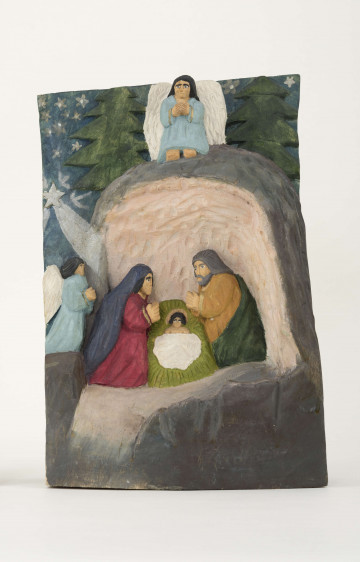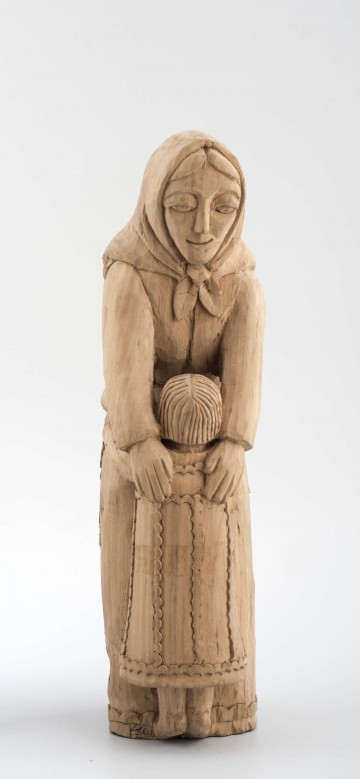
Nativity scene
1982
National Museum in Lublin
Part of the collection: Folk Art of the Lublin Region (17th–1st half of the 20th c.)
Sculpture, similarly to painting, in folk culture being an expression of artistic and spiritual needs, expressively reveals the individuality of its creators. In the 19th and early 20th centuries, sculptural representations were associated with religious worship. Since 1960, when the fashion for folk art spread, artists from rural communities started to be promoted more widely. Apart from works on religious themes, compositions on secular themes appeared (see: E/14750/ML) depicting scenes from village life (see: E/16317/ML) or family and annual rituals.
A sculpture centre was established in Wola Gułowska near Łuków in 1965. It was interesting because this kind of art had no prototypes in this area and its character was shaped within only a dozen or so years after its establishment. Marian Adamski (1929-2007) from Sobiska, influenced by his brother-in-law Henryk Wierzchowski, a well-known sculptor from the Sierpc area of Mazovia, began to sculpt. His sons Zenon (1952-2012) and Tadeusz (born 1956; see E/15826/ML) and further relatives and neighbours followed in his footsteps. The sculptors tried to reproduce the formal features of traditional sculpture, introducing their own compositional solutions. The more elaborate masses of their works showed movement and asymmetry while maintaining the expression of the form and sincerity of the message. They worked in various types of softwood: linden, poplar, willow and birch. In the early days, they made their own chisels, as well as a paste made of wax and turpentine, which they used to protect the surface of sculptures previously painted with watercolour, poster or water paints. Each developed his own style.
One of the sculptors was Marian Łubianka (1946-2019). He started creating his first sculptures in 1970. His favourite form were bas-reliefs in which he depicted everyday life of a village in different seasons of the year and its inhabitants during household and economic activities, including preparing and eating meals, working in an apiary, a sawmill or a smithy. He covered all his works with polychrome and his wife Elisabeth helped him with the painting. He took part in many local and national competitions and fairs. In 1978 he won the first prize in the competition "Folk Art as a Chronicle of Polish Countryside Traditions". His sculptures are in the collections of museums in Łuków, Lublin, Cracow and Warsaw.
Author / creator
Dimensions
cały obiekt: height: 28 cm, width: 45 cm
Object type
sculpture
Technique
polychromy
Material
wood, paint
Creation time / dating
Creation / finding place
Owner
The National Museum in Lublin
Identification number
Location / status

1982
National Museum in Lublin

1983
National Museum in Lublin

1975
National Museum in Lublin
DISCOVER this TOPIC
Museum of King Jan III's Palace at Wilanów
DISCOVER this PATH
Educational path